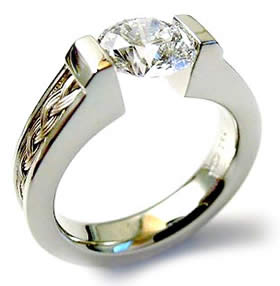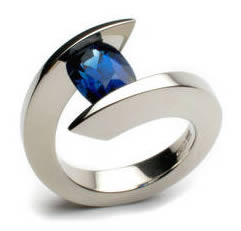Your Details
Your Details
|
Reviewed By Andreas Zabczyk
Tension Settings Gelin & Abaci Tension Setting
Tension settings in jewelry create a striking display by using pressure to hold gemstones in place, rather than traditional prongs. This innovative technique allows for maximum light exposure, enhancing the stone's brilliance and visual impact. Often seen in engagement rings and contemporary designs, tension settings provide a modern aesthetic while ensuring the stone is securely held. The result is a seamless, elegant look that highlights the beauty of the gem, making it appear as if it's floating above the band. Tension setting was first invented by Friedrich Becker, at the German company, Niessing, in the 1960s. But Niessing did not release a product with this type of setting until 1981. Technically, this type of setting presents some challenges. The metal band that holds the gemstone is actually spring-loaded to exert pressure on the gemstone in order to hold it in place. This requires special strength in the metal. The original Niessing design was made of 18 kt gold, and the 25% alloying metals were not typical jewelry metals. The entire setting weighed 35 grams and appeared unusually bulky on the finger. Therefore, an American, Steven Kretchmer, patented a new and very strong platinum alloy in 1987, and a number of companies have licensed this metal for tension-set rings. These rings are much lighter without sacrificing strength. Tension settings actually use compression rather than tension to hold the gem in place. Tiny grooves in the metal allow the girdle of the gemstone to sit in the ring so that pressure is applied evenly to the stone. The tension setting applies about 12,000 pounds of pressure per square inch on the gemstone. As a result, only very hard stones - those with a Mohs hardness score of 9 or greater can be mounted in these settings.  Tension-Set Sapphire
Tension settings must be manufactured specifically for the particular gemstone to be set into. The specifications are so exact that these rings cannot be resized; an entirely new ring must be made for a new size. More and more jewelers are embracing tension settings, transforming what was once a highly specialized niche into a growing trend in the industry. While a select few companies initially dominated the market with their high-quality products, an increasing number of artisans and brands are now exploring this innovative technique, offering a wider range of beautiful and secure tension rings to customers. Though the tension setting looks slightly precarious, the manufacturers assure customers that these settings are actually more robust than a traditional prong setting, where it is not unknown for a prong to break. As long as the spring-loading of the ring is not lost, it is almost impossible for the gemstone to fall out. |
